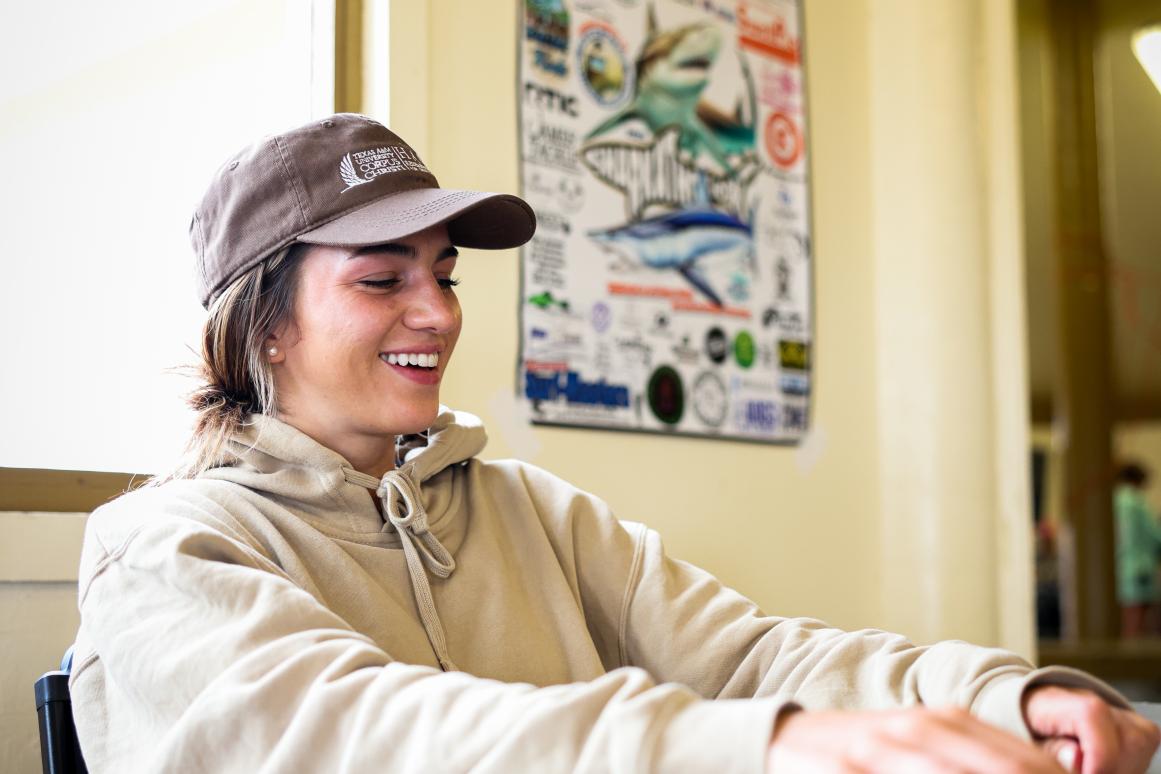Shark Week Inspires a Career Rooted in Research and Community Collaboration

CORPUS CHRISTI, Texas — Jensen Smith ’21, ’26 has been captivated by sharks since she was a child.
“My mom has a picture of me when I was itty bitty, and I’m watching Shark Week with my eyes wide open, thinking, ‘I love this,’” said Smith, who is from South Lake Tahoe in Northern California.
Fast forward nearly two decades, and that childhood wonder has grown into a full-blown passion for shark research and marine science. Now, as Shark Week returns to screens across the country, starting July 20, Smith is living out the dreams sparked by those early TV episodes.
Today, Smith is a graduate research assistant at the Center for Sportfish Science and Conservation (CSSC) at the Harte Research Institute (HRI) at Texas A&M University-Corpus Christi (TAMU-CC).
Smith’s role is part of TAMU-CC’s extensive shark research program, which takes center stage each summer during Shark Week. From the CSSC to campus labs, TAMU-CC’s researchers — including Smith — are helping lead the way in shark science along the Gulf Coast.
As she pursues her master’s degree in marine biology, part of her work includes collaborating with two conservation-focused shark fishing events along the Texas coast, the Texas Shark Rodeo and Sharkathon.
Both tournaments are catch-and-release only and offer unique opportunities for citizen scientists to contribute valuable data to HRI’s shark research. Anglers tag sharks they catch during the events, helping researchers study species abundance, movement patterns, and life history. HRI’s partnership with these events goes back more than 15 years — during which nearly 13,000 sharks have been tagged.
“Texas Parks and Wildlife has 33 of 39 species on the Species of Greatest Conservation Need (SGCN) list unranked due to data deficiency or listed as at least ‘vulnerable,’” Smith explained. “Working with these anglers and collecting data on what species are out there helps us tremendously. Without access to this kind of information, we’d be missing important data.”
One of Smith’s mentors at HRI, Associate Research Scientist Dr. Kesley Banks, helped forge the relationship with the tournament organizers, allowing Smith and others to continue the work started years ago.
When anglers catch sharks, they keep them in or as close to the water as possible while taking DNA samples and attaching tags. These tags help HRI scientists better understand growth rates, migration patterns, and overall population health.
In fact, this information is also a key part of Smith’s graduate research project, titled “Partnering with Recreational Anglers in Order to Characterize the Texas Shore-based Shark Fishery.”
Along with providing insight into the shore-based recreational fishery, the project also identifies species and size trends of sharks caught and explores factors influencing anglers’ decisions to harvest or release them.
It’s an opportunity to collect data that might not be available elsewhere.
“Data aside, I really think it helps everybody come together as a community,” Smith said. “A lot of relationships are getting stronger. People feel more comfortable approaching scientists and saying, ‘Hey, I don’t know if this means anything, but here’s what I saw.’ And we feel more comfortable reaching out too, and asking, ‘Hey, are you guys seeing this?’”
HRI’s unique relationship with fishing tournaments along the Texas coast offers anglers a chance to enjoy their sport while contributing to the conservation of ocean apex predators.
“Whether it’s a regular fishing tournament or one of these shark tournaments, you don’t realize how much data you can get from them,” Smith said. “It’s fun chatting with anglers after the tournament. They’re always so excited to share what they saw and what they caught.”
What started with wide eyes and Shark Week episodes has turned into real-world research — and real-world impact.
